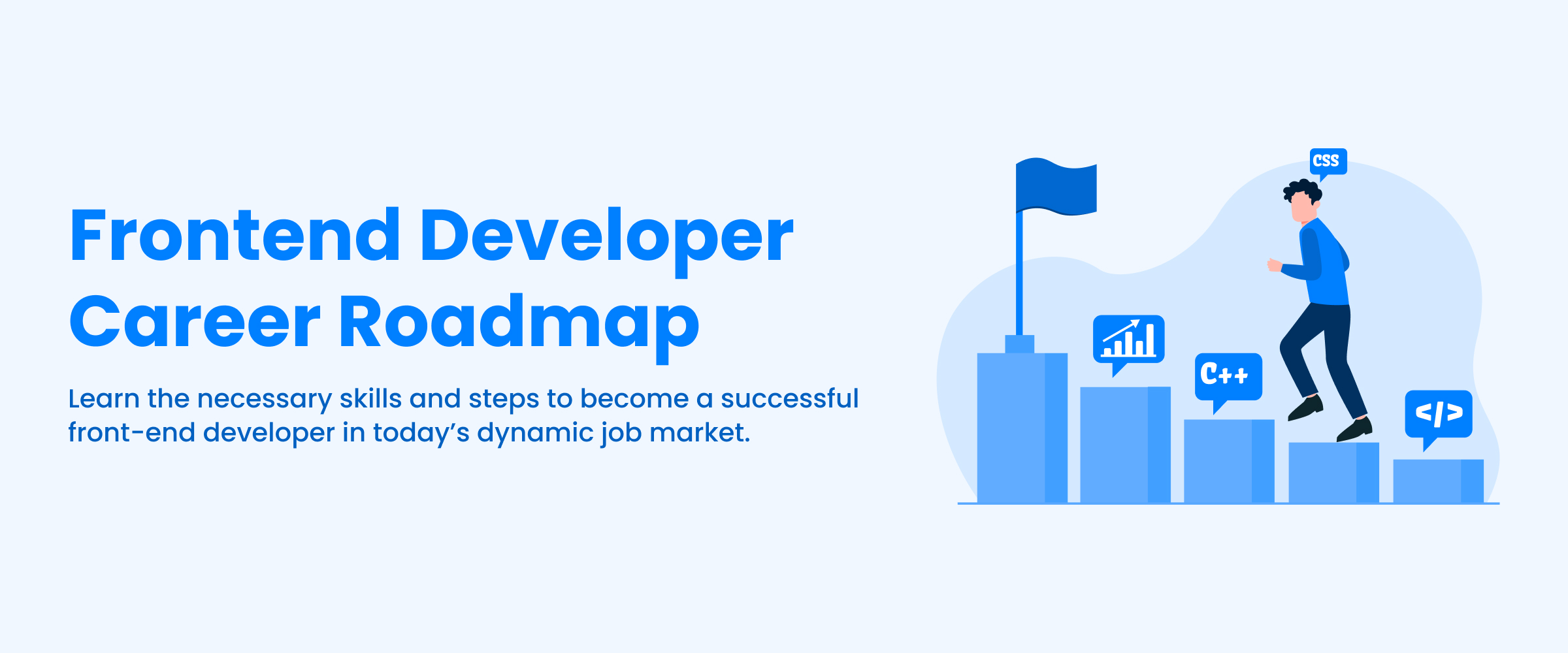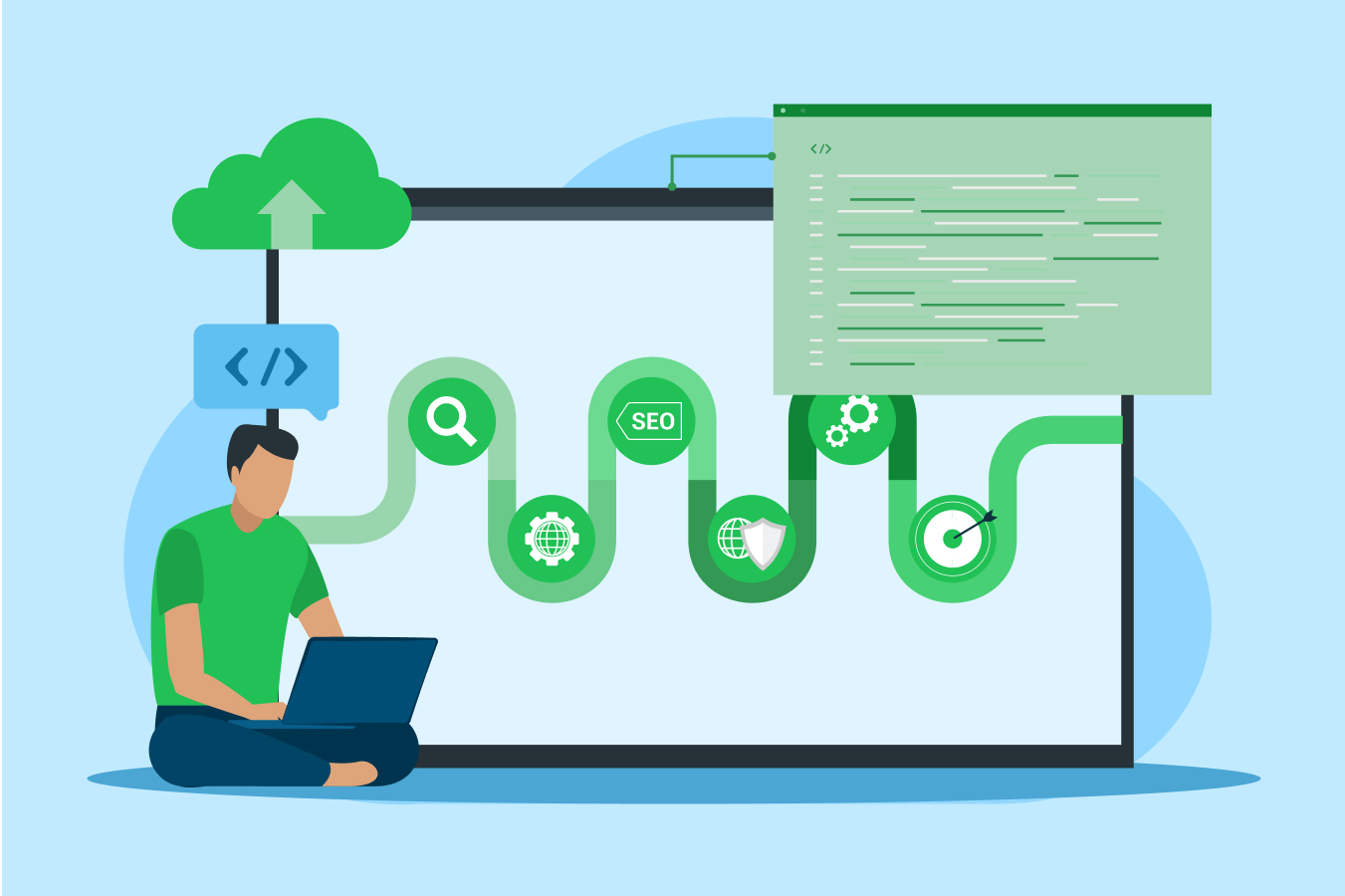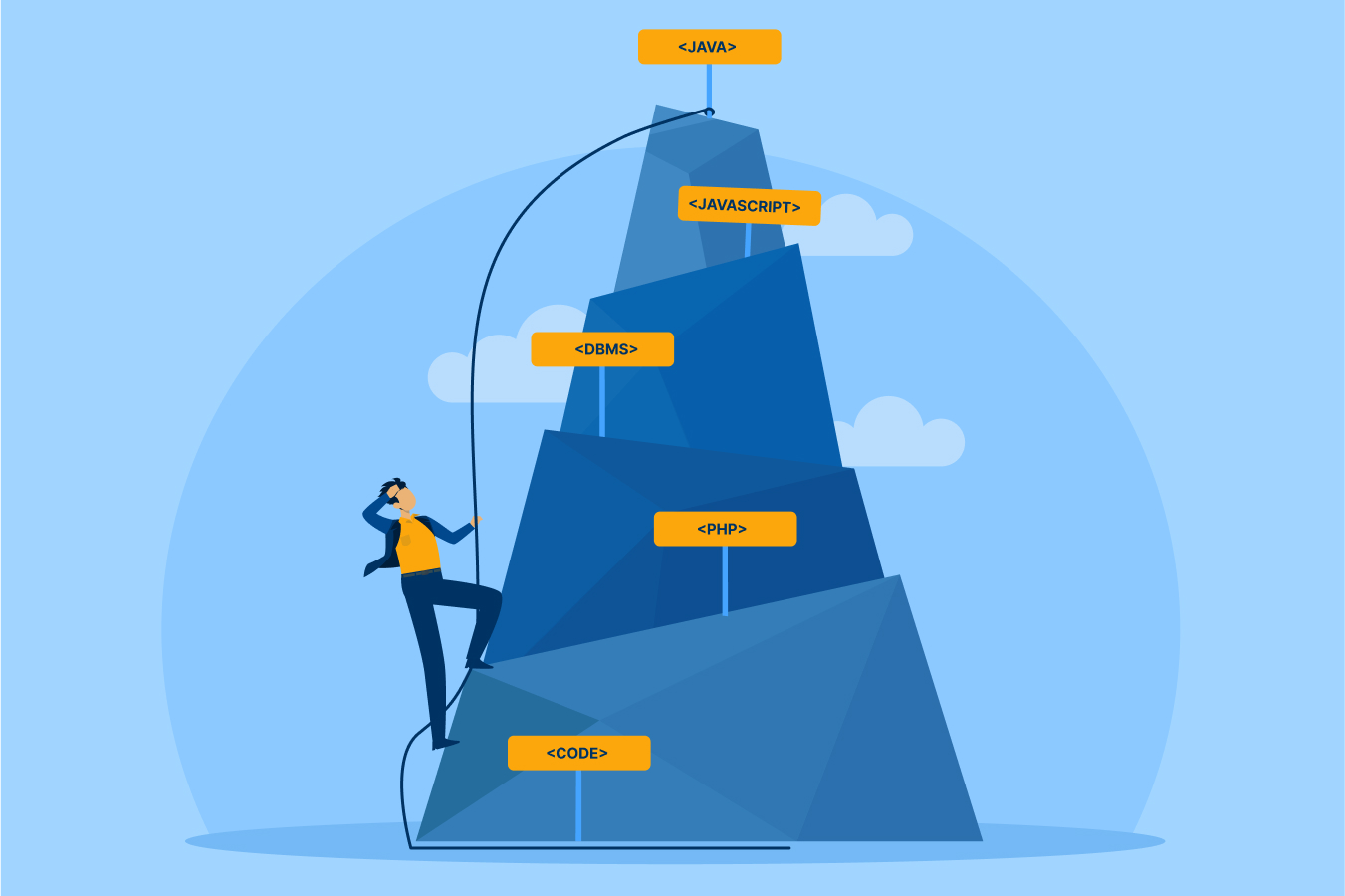Frontend Roadmap for Beginners: A Guide to Kickstart Your Career
Web development is a crucial aspect of creating a business’s online presence. Within the web development domain, the front end plays a pivotal role in crafting the user interface and experience of websites and web applications. If you want to excel in this career, understand the front-end roadmap.
Frontend developers design and implement visual elements, user interactions, and the website’s or application’s look. Whether creating visually appealing layouts, implementing smooth animations, or ensuring seamless user experiences across various devices, front-end developers are the driving force behind the aesthetics and interactivity of the digital experiences we engage with daily.
Why Learn Front-End Development?
Front-end development has become an in-demand IT skill. Companies invest in responsive user experiences to enhance customer engagement, improve brand perception, and drive conversions. As a result, skilled front-end developers are in high demand. Front-end developers build fast and engaging websites and applications.
Let’s look at why learning front-end development would be great for your career:
- High Demand and Job Prospects: NASSCOM reports that India’s IT industry is projected to reach $350 billion by 2030. This shows the growing requirement for front-end developers. MNCs like TCS, Infosys, Wipro, and HCLTech and startups like Zepto, Blinkit, and Myntra hire front-end developers to run their online operations, websites, and apps.
- High Salaries and Growth: Due to the growing demand for front-end developers, the salary has become quite competitive. Companies offer ₹4 LPA – ₹6 LPA to entry-level professionals, ₹8 LPA – ₹15 LPA for mid-level developers, and ₹20 LPA+ to senior-level professionals.
- Remote & Freelance Work Opportunities: As per a report by Glassdoor, 70% of front-end developers in India work remotely or hybrid. It highlights the flexibility of this job role. Freelance developers can earn up to ₹2 lakhs per freelance project.
- Versatility: Learning front-end development makes you eligible for various roles like full-stack development, mobile app development, UI/UX development, and more. Startups and Fortune 500 companies hire front-end developers across IT, e-commerce, fintech, ed-tech, healthcare, media, travel, etc.
- Evolving and Trending Career: With the advancements in AI, Web3, and interactive web experiences, the demand for front-end developers has grown rapidly. Companies recruit skilled developers to create dynamic and secure platforms by integrating machine learning and blockchain technology. This makes front-end development a future-proof career.
How to Become a Frontend Developer?
Embarking on a career as a front-end developer can be an exciting and rewarding journey. However, to excel in this field, you need to follow a structured front-end web development roadmap. To kickstart a career in web development, consider taking a full-stack development course with a placement guarantee. This course equips you with the knowledge and expertise needed to excel in the field.
Given below is a comprehensive guide to help you begin learning front-end development.
Step 1: Understand How the Internet Works
Before delving into the core of front-end development, it’s crucial to grasp the fundamentals of how the Internet functions. This includes an understanding of domains, protocols like HTTP/HTTPS, servers, and the Domain Name System (DNS). For anyone looking to venture into web development, basic knowledge of web browsers, their role, and how they render web pages is essential.
Understanding the underlying infrastructure and mechanics of the Internet will provide a solid foundation and aid in developing efficient and secure web applications. This knowledge will help you troubleshoot and debug issues more effectively. You will have a better understanding of how various components interact with each other.
Step 2: Master the Basic Programming Languages
The three pillars of front-end development are HTML, CSS, and JavaScript. Mastering these languages is important if you want to become a front-end developer. Here’s an overview of the programming languages:
- HTML (HyperText Markup Language)
HTML forms the backbone of any website or web application. It’s a markup language used to structure the content and elements of a web page. From headings and paragraphs to images and links, HTML provides the basic building blocks for creating the layout and organization of a website.
To become proficient in HTML, learn about HTML tags, elements, and attributes. You should also learn how to create semantic and accessible markup crucial for search engine optimization (SEO) and ensuring that your web pages are accessible to Internet users.
- CSS (Cascading Style Sheets)
While HTML provides the structure, CSS is responsible for the visual styling and presentation of a website. CSS allows you to control the layout, colors, fonts, and overall aesthetic appeal of your web pages. With CSS, you can create visually stunning and responsive designs that adapt seamlessly to different screen sizes and devices.
To master CSS, you’ll need to understand selectors, properties, and values, as well as advanced concepts like CSS preprocessors (e.g., Sass, Less, or Stylus), CSS frameworks (e.g., Bootstrap, Tailwind, and Materialize), and CSS animations.
- JavaScript
JavaScript is the programming language that brings interactivity and dynamic behavior to web pages. With JavaScript, you can create interactive user interfaces, validate form data, manipulate the Document Object Model (DOM), and fetch data from servers using APIs.
To become proficient in JavaScript, understand its syntax, data types, control structures, functions, objects, and event handling. Additionally, you should familiarize yourself with modern JavaScript features like arrow functions, async/await, etc.
Step 3: Learn the Concept of Responsive Design
In today’s world, where users access websites and applications from various devices, desktops smartphones, and tablets, it is crucial to create responsive designs. Responsive web design ensures that your web pages adapt and provide an optimal viewing experience across different screen sizes and resolutions.
To achieve responsive design, you need to understand and apply techniques like media queries, flexible layouts, and responsive images and typography. Bootstrap and Foundation simplify creating responsive designs by providing pre-built components and grid systems. You can learn the difference between web design and web development to ensure design consistency in your websites.
Step 4: Explore JavaScript Frameworks
Modern front-end development leverages JavaScript frameworks and libraries to streamline development, improve code organization, and enhance performance. Here are some popular JavaScript frameworks that you should consider learning:
- React: Developed and maintained by Facebook, React JS is a JavaScript library for building user interfaces. It uses a component-based architecture, which allows for the creation of reusable UI components.
- Vue.js: Vue.js is a progressive JavaScript framework that focuses on simplicity and ease of use. It combines the best features of other frameworks while remaining lightweight and approachable.
- Angular: Angular is a comprehensive TypeScript-based framework developed and maintained by Google. It follows a modular structure and provides a robust set of features and tools for building scalable and maintainable web applications.
Step 5: Understand Bootstrap 5 and SASS
While CSS provides the foundation for styling web pages, frameworks and preprocessors can greatly enhance your workflow and productivity. They elevate your skills in creating modern, visually appealing websites that seamlessly adapt to various devices and screen sizes.
- Bootstrap 5
Bootstrap is a popular front-end framework that provides a collection of pre-designed components and a responsive grid system. It simplifies the process of creating visually appealing and responsive layouts, allowing you to prototype and build user interfaces with minimal effort. By learning Bootstrap 5, you gain access to a vast library of reusable UI components, such as navigation bars, buttons, forms, modals, and carousels. Additionally, Bootstrap’s grid system makes it easy to create responsive layouts that adapt to different screen sizes and devices.
- SASS (Syntactically Awesome Style Sheets)
SASS is a CSS preprocessor that extends the functionality of CSS. It introduces features like variables, nesting, mixins, variables, and partials, making it easier to write and maintain CSS code. With SASS, you can organize your styles more efficiently, reduce code duplication, and create reusable style patterns. This improves code readability and maintainability and enhances your productivity as a front-end developer.
Step 6: Learn Version Control Using Git and GitHub
Version control is an essential aspect of software development, allowing developers to track changes, collaborate on projects, and manage code repositories effectively. The popular version control systems are Git and GitHub.
Git is a popular distributed version control system, and GitHub is a web-based hosting service for Git repositories. Taking a Git and GitHub course will equip you with the necessary skills to effectively manage version control and collaborate on projects with ease. Some of the benefits include:
- Track and manage changes to your codebase.
- Collaborate with other developers on projects.
- Contribute to open-source projects.
- Host and share your projects with the development community.
Step 7: Build a Winning Portfolio
Having a strong portfolio is essential for showcasing your skills and demonstrating your expertise to potential employers or clients. Your portfolio should include a collection of projects that highlight your abilities in various areas of front-end development, such as responsive design, user interface development, and integration with backend systems.
When building your portfolio, focus on creating visually appealing and functional projects that showcase your problem-solving skills, attention to detail, and creativity. Your portfolio can be hosted on platforms like GitHub Pages, Netlify, or your website, making it easily accessible to potential employers or clients.
Job Opportunities as a Front-End Developer
The front-end development field offers various career opportunities. You may start your career as a front-end developer, UI/UX designer, etc. Here are some of the popular career options that you can explore:
- Front-end Developer: These developers create, maintain, and optimize the website or app’s visual aspects and user interfaces. They are responsible for converting designs into functional webpages using HTML, CSS, and frameworks like React JS and Angular.
- UI/UX Developer: As the name suggests, these developers work closely with designers to develop visually appealing UI and seamless UX for websites and apps. They convert wireframes and prototypes into functional web interfaces that ensure an intuitive user experience. To become a UI/UX developer, you must know UI/UX design principles, Figma, and JavaScript libraries.
- Web Developer: A web developer creates and maintains functional websites using HTML, CSS, and JavaScript. These developers work on both the front end and back end of a website. To become a web developer, you should be proficient in MySQL, MongoDB, Python, CSS, etc.
- Mobile Front-end Developer: These professionals develop user-friendly and interactive interfaces for mobile apps. iOS and Android using technologies like React Native, Flutter, or Swift UI. They are responsible for integrating APIs and implementing touch-based interfaces. To put it simply, the user interface of all the apps that you use, from Instagram to Zomato, is built by mobile front-end developers.
- Web3 Front-end Developer: These developers build dApps or decentralized apps like crypto wallets, NFT marketplaces, and DeFi platforms. These apps run on blockchain networks like Solana, Ethereum, or Polygon, so a Web3 front-end developer must be proficient in these technologies as well as frameworks like react.js or Vue.js. Web3 developers are in high demand globally and can demand high salaries, making it an excellent job prospect.
Front-End Developer Salary Scope
Front-end development is a highly sought-after skill, making it an excellent career option for freshers as well as experienced professionals. Typically, start-ups and product-based companies pay higher salaries than traditional IT firms and service-based companies. The salary of a front-end developer varies based on technical skills, experience, and the type of company. In most cases, it is higher than its non-technical counterparts.
Here is the front-end developer salary you can expect:
- Entry-Level Roles: Beginners with a working knowledge of HTML, CSS, JavaScript, and basic frameworks can expect between ₹4 LPA to ₹6 LPA at some top IT companies like TCS, Infosys, Cognizant, etc.
- Mid-Level Roles: Developers with experience in UI/UX development, performance optimization, APIs, and frameworks can expect an annual salary package of ₹6 LPA to ₹18 LPA. Companies like Swiggy, Zomato, Paytm, and Zoho, actively hire such developers.
- Senior-Level Roles: Professionals proficient in advanced frameworks, architecture, and leadership charters can earn between ₹12 LPA and ₹30 LPA+. These developers can easily secure jobs at companies like Microsoft, Google, Adobe, etc.
Conclusion
Embarking on a career as a front-end developer can be a rewarding and exciting journey. By following this comprehensive front-end roadmap, you’ll gain the necessary skills and knowledge to thrive in the field of web development. Remember, learning is a continuous process, and staying up-to-date with the latest trends and technologies is crucial for maintaining a competitive edge in the industry.
FAQs
Yes, it is possible to gain proficiency in front-end web development within three months through dedicated and intensive training. Immersive boot camps and certificate programs can provide a structured learning path and curriculum to help you acquire the necessary skills. However, it’s important to note that continuous practice and hands-on experience are crucial for solidifying your knowledge.
To embark on your journey as a front-end web developer, the first step is to build a solid foundation in the three core programming languages: HTML, CSS, and JavaScript.
a) Begin by understanding HTML, the markup language that structures web content.
b) Then, delve into CSS to master the art of styling and layout design.
c) Finally, explore JavaScript, the programming language that brings interactivity and dynamic behavior to web pages.
Yes, front-end web developers are responsible for writing code that creates and maintains the user interface of websites and web applications. This ensures a seamless and consistent experience across various devices, screen sizes, and web browsers. While the complexity of this task has evolved, front-end developers still write code that can operate effectively within different web platform runtimes, such as different browser engines.
Yes, becoming a front-end developer in 2025 is worth it. With businesses prioritizing seamless digital experiences, the demand for skilled front-end developers continues to grow. Companies require professionals who can create visually appealing, fast, and user-friendly websites and applications.
AI can automate tasks, saving time, effort, and money. However, AI cannot replace human problem-solving abilities, creativity, and understanding of user pain points and interactions. Having said that, front-end developers who leverage AI are more efficient and sought after.
It depends on your area of interest. Both frontend and backend are highly in-demand and offer incredible job prospects. Companies pay lucrative salaries for both roles.






